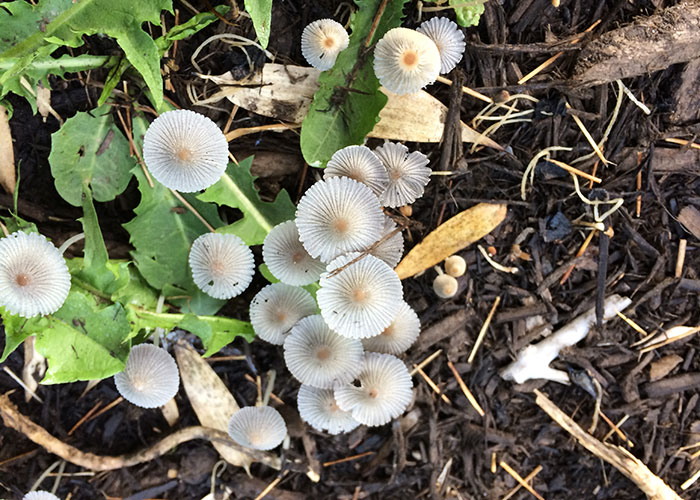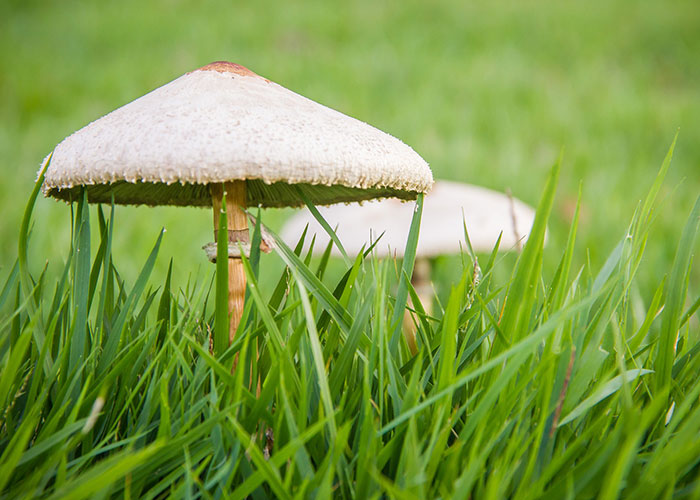Mushrooms: A Sign of Healthy Soil

As the fall rain returns, mushrooms tend to pop up in our gardens overnight. And just as abruptly, all kinds of questions and concerns pop up as well. Gardeners want to know if mushrooms will harm their plants, their children, and their pets. They want to know where they came from and how to get rid of them.
Some gardeners come into Sky Nursery having already labeled mushrooms as the enemy, and fully prepared to douse their entire garden in fungicides. Please don’t! Your garden soil is a living ecosystem, and mushrooms have an important role to play.
The truth is that mushrooms are a good thing for your garden. While a little risk management may be warranted if you have curious kids or pets, mushrooms definitely don’t deserve to be treated with fear or animosity. In fact, a healthy mushroom population is something to celebrate! Let’s take a closer look at these harbingers of healthy soil.
Just Part of the Whole
Mushrooms tend to be more feared than understood. Some gardeners mistake them for plants, or maybe just view them as hostile invaders without thinking too much about what exactly they are. But the truth is much more interesting.
Mushrooms are just temporary structures made by much larger underground fungi. The sole purpose of a mushroom is to help its fungus reproduce. They pop up in damp weather because fungus spores need damp to spread. The spores are held in the gills under the mushroom cap, and released when the time is right. Once a mushroom accomplishes this mission, it will quickly rot back into the earth.
"Once a mushroom accomplishes [its] mission, it will quickly rot back into the earth."

Helpful Hyphae
The fungi that produce mushrooms live in your soil year-round, in the form of mycelium: a maze of root-like filaments called hyphae. You might have seen them around. If you’ve ever dug up a shovelful of mulch or rich soil and noticed it was shot through with little white hairs, you’ve seen the true shape of a fungus.
And hyphae are incredibly helpful! They help break down organic matter into nutrients that plants can use, hook up with plant roots to help them access water, and improve soil structure. They even help plants communicate with each other! In short, a healthy fungi population is essential for healthy soil.
"A healthy fungi population is essential for healthy soil."
Protect Kids & Pets
Most mushrooms are harmless, but it’s true that some can be harmful or even deadly if eaten. If you’d like to learn how to tell the difference, the Puget Sound Mycological Society is one place to start. In general, all mushrooms are harmless to all but those with specific allergies when they’re simply touched. Symptoms of mushroom poisoning may take up to a couple of days to manifest, and they can range from an upset stomach to serious organ damage.
But if that makes you want to reach for fungicides, please think again.
For one thing, it won’t work. Mycelium networks are vast, and they extend deep underground. They’ll hardly even notice a little fungicide on the soil surface. More importantly, dousing your soil with enough fungicide to have even a small, temporary effect on mushrooms will also harm your plants. As we explained above, plants and fungi are besties. Your plants won’t react well to you waging war against their allies.
If you have very young children or pets who don’t always know what’s good for them, then gently removing mushrooms might not be a bad idea. They are easy enough to break off by hand or with a rake, and they can be safely buried or put in your municipal compost bin. They will come back, but only as long as conditions are right for them, and then you can cross that chore off your list for another year.
"Plants & fungi are besties. Your plants won’t react well to you waging war against their allies. "

Have you thanked your mushrooms today?
Next time you see a mushroom popping up in your container garden or perennial bed, take a closer look. Can you see the gills under the cap where it holds its spores? Consider gently digging in the soil nearby to find out if you can see the mycelium that grew it.
Whether the hyphae are visible or too small to see, imagine them extending around or into your plants’ roots, sending them water and nutrients in exchange for the sugar your plants produce. Think about their roles as decomposers and soil engineers.
Even if you decide to snap off that mushroom and bury it, consider saying “thank you” first.
